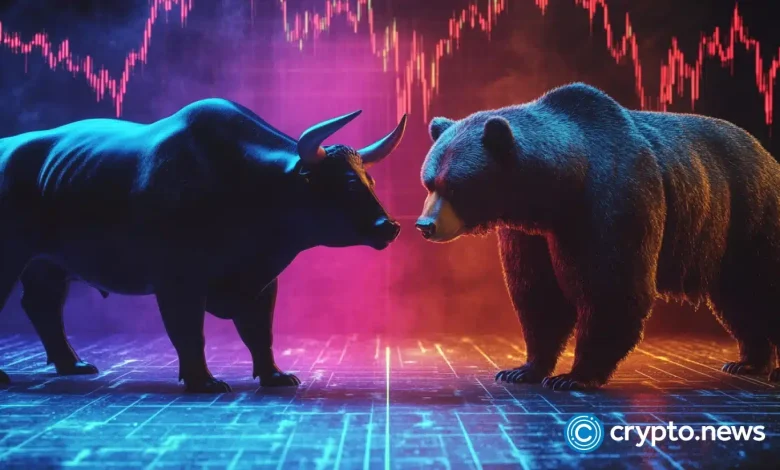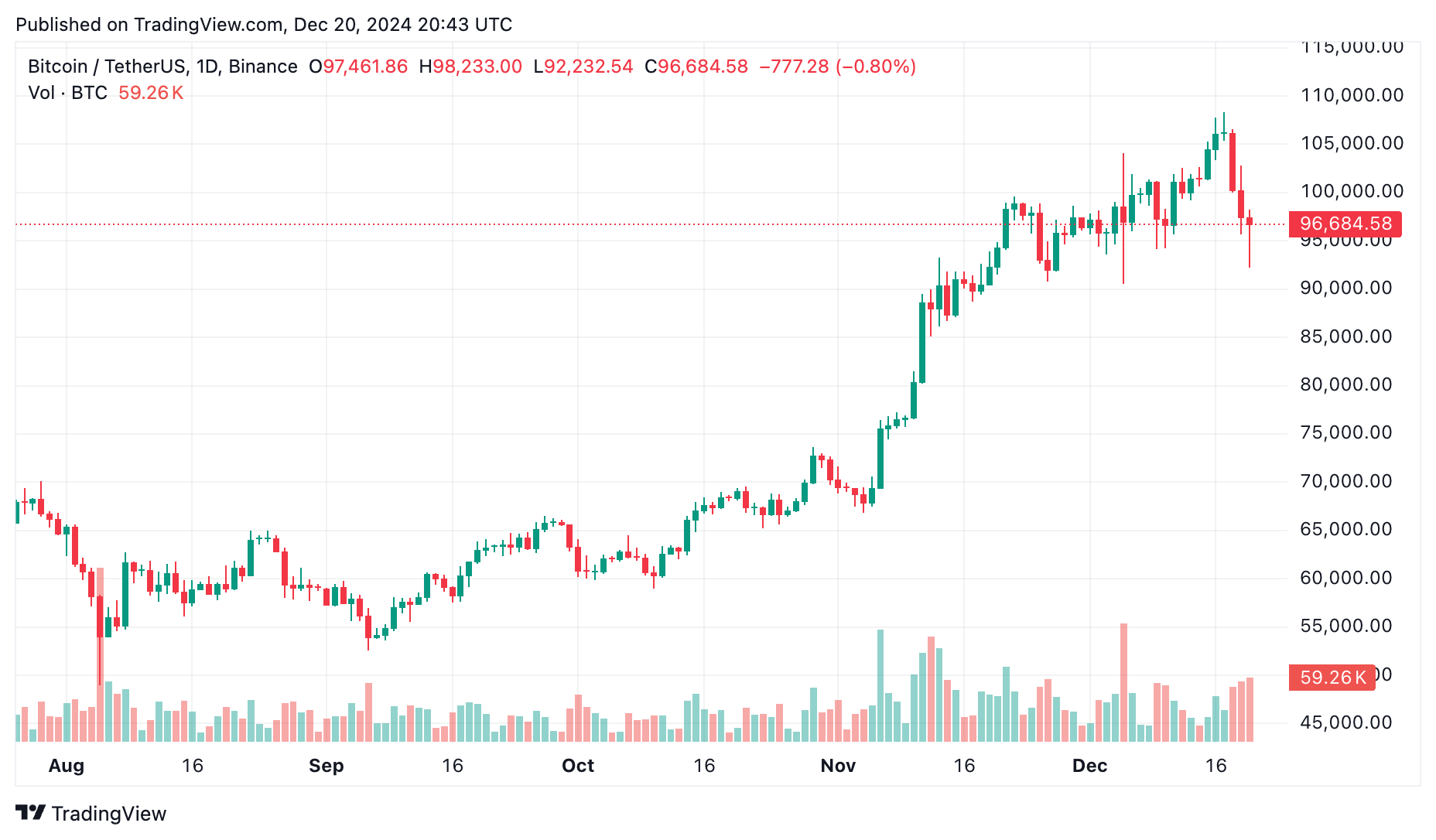Why does the crypto market decline not mark the end of the bull market?

Are the recent liquidations and price drops paving the way for a longer winter for cryptocurrencies, or could this serve as a breather before another bull run?
The cryptocurrency market is faltering as the end of the year approaches
As the year draws to a close, the cryptocurrency market appears to be pausing after a long bull run, with the global market cap falling by more than 6% to settle at around $3.47 trillion as of December 20.
Bitcoin (Bitcoin) has fallen below the crucial $100,000 mark, trading at $96,680 as of this writing — a roughly 3.5% decline over the past 24 hours.

Ethereum (Ethereum), the second-largest cryptocurrency by market cap, saw a steeper decline, falling 6% over the same period and accumulating weekly losses of 15%, leaving it at $3,400 levels.
This decline did not spare the rest of the market either. The top 100 altcoins recorded losses between 10% and 20%, while cryptocurrencies – known for their wild price swings – were the hardest hit, with an average sector-wide decline of 12%.
Dogecoin (Doug), for example, fell more than 12% to $0.31, and the Shiba Inu (Gray) fell approximately 10% to $0.0000211. Other popular tokens like Floki (Floki),bonk(Bonk) and baby (baby) followed suit, with its weekly losses spiraling between 35% and 40%.
Adding to the chaos, the futures market revealed stunning liquidation numbers. More than 374,000 traders were liquidated in the past 24 hours, with a total value of $1.37 billion. According to To Quinglass.
Of this liquidation, $1.13 billion came from long positions, a clear sign that overly optimistic bets are failing. Bitcoin alone accounted for $320 million in liquidations, mostly from long positions, while Ethereum saw a loss of $308 million, with $263 million tied to long positions.
A closer look at open interest—the total value of outstanding futures contracts—suggests that the market may be entering a bearish phase.
Bitcoin open interest has been rising steadily over the past few months, rising from $32 billion in early October to $68 billion by December 18. However, this has now gone up. decreased To $62 billion as of December 20, coinciding with the sharp decline in prices.
Typically, when open interest and prices decline, it indicates downward momentum, as it reflects traders closing their positions and reducing exposure during market uncertainty.
Interest rate moves by the Federal Reserve raise volatility
There may be a sharp correction in the cryptocurrency market attributed This is largely due to the recent interest rate decision made by the US Federal Reserve and the accompanying comments.
On December 18, the Federal Reserve announced its third rate cut of the year, lowering the federal funds rate by 0.25% to 4.5%.
While the move was widely expected and brought this year’s cumulative reduction to 1%, the central bank’s messaging carried a more cautious tone.
Fed officials explained that only two additional cuts are scheduled for 2025, and that any further adjustments will depend on inflation trends and general economic conditions.
The Fed’s measured approach reflects its ongoing struggle to control inflation, which is expected to remain above its 2% target through at least 2026.
This announcement sent shock waves through financial markets, especially risk-sensitive assets such as cryptocurrencies and stocks. US stock markets reacted sharply, with the Dow Jones and Nasdaq 100 falling more than 2%.
Meanwhile, bond yields rose as investors sought safety in Treasuries. The yield on 10-year bonds rose to 4.557%, while the yield on 30-year bonds reached 4.7%.
Meanwhile, the US dollar index rose to its highest level in two years, further tightening financial conditions and increasing pressure on global markets, including cryptocurrencies.
Bitcoin’s rise above $100,000 earlier this month was certainly a milestone, and Ethereum’s rise above $3,500 has sparked widespread optimism.
However, such euphoric feelings often prompt traders to take profits, especially when markets show sharp corrections after extended rallies, as risk appetite declines and traders adjust their positions.
This time was no different. As investors turned to safer options like Treasuries and cash, cryptocurrencies faced the double whammy of falling demand and panic selling.
The selling quickly escalated, leading to widespread liquidations as leveraged positions were aggressively unwound in the futures markets. The cascading effect of these events led to a sharp decline in prices, pushing the cryptocurrency market firmly into correction territory.
Traditional market volatility drags cryptocurrencies down
The recent turmoil in traditional financial markets extends to the cryptocurrency space, with Bitcoin feeling the brunt of macroeconomic pressures that have left investors scrambling.
A closer look at the situation through the lens of Kobeissi Letter analysis sheds light on how rising volatility, changing market correlations and broader macroeconomic conditions are shaping the current narrative for Bitcoin and cryptocurrency assets.
The Volatility Index (VIX), often referred to as the “fear gauge” for traditional markets, rose almost 100% this week, indicating growing uncertainty.
This rise coincides with the hawkish stance of the Federal Reserve, which, despite cutting interest rates on December 18, indicated a slowdown in the pace of upcoming cuts, rattling risk assets, including Bitcoin, as higher interest rates for a longer period make investments… As safe as the United States. Treasuries are increasingly attractive.
The 10-year Treasury yield has now risen to 4.5%, with fears of a rise towards the 5% level, a threshold that has previously led to corrections in both stock and cryptocurrency markets.
Digging deeper, Bitcoin’s performance can often be understood in relation to its correlation with traditional financial indicators.
Earlier this year, Bitcoin shared a strong positive correlation with the Nasdaq and S&P 500 – peaking at 0.9 and 0.86 respectively in June. This means that Bitcoin has largely moved in tandem with technology stocks, benefiting from the same risk-on sentiment.
However, in mid-July, this correlation flipped to -0.87 and -0.86, indicating a rare divergence as Bitcoin briefly acted as a hedge during stock market weakness.
More recently, as of December 19, these correlations have fallen to 0.57 for the Nasdaq and 0.38 for the S&P 500. While Bitcoin is still reacting to macroeconomic shifts, its price movements have begun to reflect unique pressures, such as spot inflows and outflows from funds. Traded investment. And other developments related to cryptocurrencies in the United States
In the short term, Bitcoin faces a series of hurdles. Rising Treasury yields are shifting institutional capital toward safer assets, while stocks struggle to find support amid rising volatility.
However, the weak correlation between Bitcoin and traditional indicators suggests that the cryptocurrency market is not entirely beholden to broader market trends.
This disconnect, if it persists, may allow Bitcoin to craft a more independent narrative, but only if it is able to weather the current macroeconomic storm.
Experts Take: Is This a Break for the Bull Market?
Experts remain divided on Bitcoin’s short-term path, but there is a common theme: This correction, although troubling, may not signal the end of the bull market.
Lark Davis draws on historical parallels to provide perspective. “In December 2020, Bitcoin fell 12% after a massive rally, only to rise 136% over the next 23 days.” He notes that the current 13% decline comes on the heels of a similarly strong performance in the fourth quarter.
While Davis warns that a further 10-15% correction is still possible, he asserts that “there is a lot of fuel left in the tank” for Bitcoin and the broader cryptocurrency market.
Adding to this perspective, Rekt Capital says that corrections during price discovery stages are common and necessary. “Price discovery corrections tend to last a few weeks, and there are usually up to four in a bull market cycle.”
According to Rekt Capital, this is the first correction of its kind in the current cycle, making it “an ideal opportunity to reaccumulate with a high probability of a price reversal to the upside.”
Michael van de Poppe takes a slightly different angle, focusing on the possibility of consolidation. He points out that Bitcoin’s drop below $102,000 led to a sharp decline in altcoins, but such volatility is to be expected in a high-growth market.
“These are opportunities, and these declines will continue,” he says. From here, Bitcoin is expected to strengthen while altcoins are likely to see another rally.
Beyond these short-term assessments, macro developments point to longer-term opportunities. Groupe BPCE, a large French bank with 35 million users and $1.5 trillion in assets, has received approval to launch Bitcoin and cryptocurrency investment services, Bitcoin Magazine reported.
Bitcoin’s continued integration into mainstream financial ecosystems, coupled with its increased accessibility to retail investors, could serve as a counterweight to current market concerns.
However, there are still risks. High Treasury yields, macroeconomic uncertainty, and increased volatility in traditional markets continue to pose challenges.
Traders and investors should be careful, as more volatility can lead to more declines. Trade wisely and never invest more than you can afford to lose.
Disclosure: This article does not constitute investment advice. The content and materials contained on this page are for educational purposes only.
https://crypto.news/app/uploads/2024/08/crypto-news-A-bull-a-bear-option05.webp
2024-12-20 20:49:00




